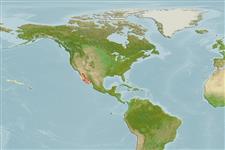Teleostei (teleosts) >
Perciformes/Serranoidei (Groupers) >
Serranidae (Sea basses: groupers and fairy basslets)
Etymology: Paralabrax: Greek, para = the side of + Greek, labrax, -akos = a fish, Dicentrarchus labrax (Ref. 45335).
Environment: milieu / climate zone / depth range / distribution range
Ecology
Marine; demersal; depth range 40 - 107 m (Ref. 9342). Subtropical; 32°N - 23°N
Eastern Central Pacific: Baja California, Mexico and the Gulf of California.
Size / Weight / Age
Maturity: Lm ? range ? - ? cm
Max length : 71.0 cm TL male/unsexed; (Ref. 9342); max. published weight: 2.7 kg (Ref. 40637)
Found on rocky bottoms, between 40 and 107 m depth. An important game fish.
Life cycle and mating behavior
Maturities | Reproduction | Spawnings | Egg(s) | Fecundities | Larvae
Heemstra, P.C., 1995. Serranidae. Meros, serranos, guasetas, enjambres, baquetas, indios, loros, gallinas, cabrillas, garropas. p. 1565-1613. In W. Fischer, F. Krupp, W. Schneider, C. Sommer, K.E. Carpenter and V. Niem (eds.) Guia FAO para Identification de Especies para lo Fines de la Pesca. Pacifico Centro-Oriental. 3 Vols. FAO, Rome. (Ref. 9342)
IUCN Red List Status (Ref. 130435)
Threat to humans
Harmless
Human uses
Fisheries: minor commercial; gamefish: yes
Tools
Special reports
Download XML
Internet sources
Estimates based on models
Preferred temperature (Ref.
123201): 14.6 - 19.8, mean 17.2 °C (based on 13 cells).
Phylogenetic diversity index (Ref.
82804): PD
50 = 0.5020 [Uniqueness, from 0.5 = low to 2.0 = high].
Bayesian length-weight: a=0.01349 (0.00714 - 0.02549), b=3.07 (2.91 - 3.23), in cm total length, based on LWR estimates for this species & Genus-body shape (Ref.
93245).
Trophic level (Ref.
69278): 4.1 ±0.6 se; based on size and trophs of closest relatives
Generation time: 9.6 ( na - na) years. Estimated as median ln(3)/K based on 1
growth studies.
Resilience (Ref.
120179): Low, minimum population doubling time 4.5 - 14 years (Preliminary K or Fecundity.).
Fishing Vulnerability (Ref.
59153): High vulnerability (63 of 100).
Nutrients (Ref.
124155): Calcium = 48.5 [20.7, 96.8] mg/100g; Iron = 0.786 [0.435, 1.491] mg/100g; Protein = 18.5 [16.7, 20.2] %; Omega3 = 0.349 [0.216, 0.581] g/100g; Selenium = 30 [15, 60] μg/100g; VitaminA = 14.7 [4.5, 52.5] μg/100g; Zinc = 0.646 [0.463, 0.943] mg/100g (wet weight);
